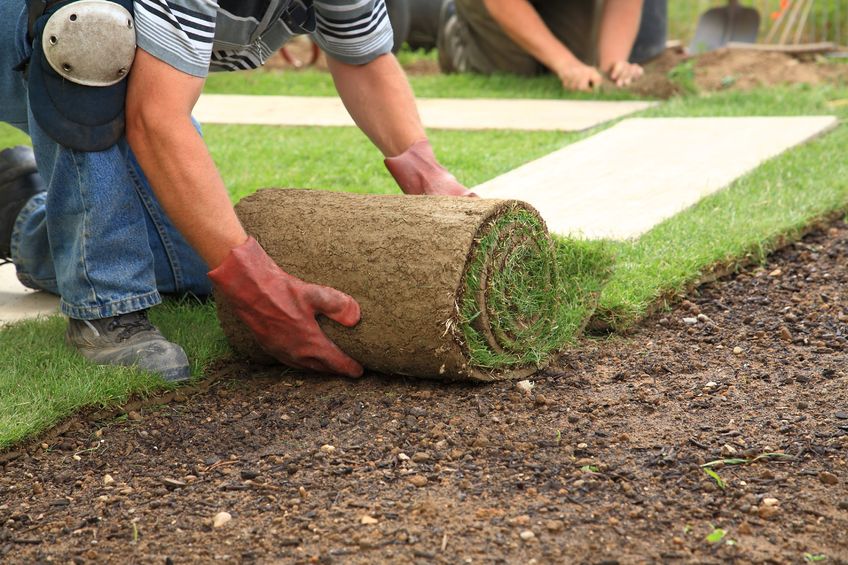Turf Laying
Creating Beautiful Lush Green Garden Lawns With Premium-Grade Turf...
The biggest secret to creating a strong, healthy, and long-lasting lawn is through the thorough preparation of the area you want to turf.
Start by removing any existing turf. This can be done with a spade or a turf cutter hired from your local tool hire shop.
Remember - plants grow above and beneath the ground so remove ALL the roots you find. Once the old grass is removed you can begin to prepare the soil for your new turf.
The aim of soil preparation is to achieve an even, firm and flat, turf-laying area of fine tilth - free of weeds, stones, and clods.
Start by digging the entire area over with a fork, down to about 150mm (6 inches). A rotavator can be useful to break soil down, however with a little more effort, the same result can be achieved with a good spade, fork and rake.
If you have poor quality soil, a blended topsoil can be added for ease of working. This will also provide a perfect turf-growing environment. The end result should be a firm, level surface - free from any soft or hollow areas, to help your newly laid turf to knit quickly into the soil.
To give your lawn the best possible start in life, apply a suitable ‘starter’ lawn feed and rake well into the soil.
How Much Turf Will You Need?
If the area to be turfed is a square or a rectangle, simply multiply the length (m) by the width (m) and add an extra 5% to allow for shaping and cutting in. Each roll of turf will cover 1m2. So it follows, if you have 20m2 to cover, then you will need 21 rolls of turf (area to be turfed + 5%). Simple as that!
For more awkward shapes it would be best to draw a plan first. Start by laying out a square or rectangle that best fits the prepared area. Continue to add rectangles that butt up against each other until the series of rectangles best represents the shape you want.
Next measure the area of each rectangle, add together, and add another 5% to allow for cutting in.
Laying The Turf
The longer turf is left rolled up, the faster it will deteriorate. So you need to start laying your new lawn as soon as the turf is delivered. If for some reason this is not possible, at least make sure the turf rolls are stored in a cool and shady place. This will slow down (though not stop) the deterioration process.
Start by laying a line of turf from one end of your prepared area to the other along a straight edge.
Butt the ends of the turf up against each other, taking care not to leave any gaps. Do not walk on the turf as you lay it. Instead, place a ‘crawling board’ on top of the laid rolls and work from this. Doing this will eliminate footprints and keep the surface smooth.
Lay the next row of turf against the first and stagger the joints (as in brickwork). Gently tamp the turf down as you go to ensure the best contact between turf and the prepared soil.
A sharp knife can be used to cut turf to shape as and when necessary.
Lawn Care – The First Few Days
During dry periods your newly laid turf will need to be regularly (every day) watered in the first few weeks. It’s best to water each evening to minimise evaporation. A sprinkler is the best option as it can provide a constant and gentle delivery - similar to rainfall.
Check the progress of your turf by gently lifting a corner of a laid roll.
After a week or so you will start to see the new roots developing. You will need to continue watering during dry periods until the new roots have firmly rooted into the soil below.
Remember, once your new lawn has established itself, ongoing care and maintenance is essential to keep it looking good.
The most important point to remember is that your new turf lawn is a mass of grass plants that need the correct balance of water, sunlight and food to survive. Just like any other living thing, your lawn will be susceptible to pests and diseases. But a good, regular maintenance regime will minimise this threat and allow your lawn to flourish and thrive for years to come.
We love lawns and happy to talk with you about your plans. Why not give us a call?
"Call 01275 269784 to book your FREE no obligation consultation"
© Wills Landscaping, 3 Pennant Place, Portishead, Bristol, BS20 7AA
Home | Privacy Policy | Terms and Conditions | Copyright Notice | Contact

